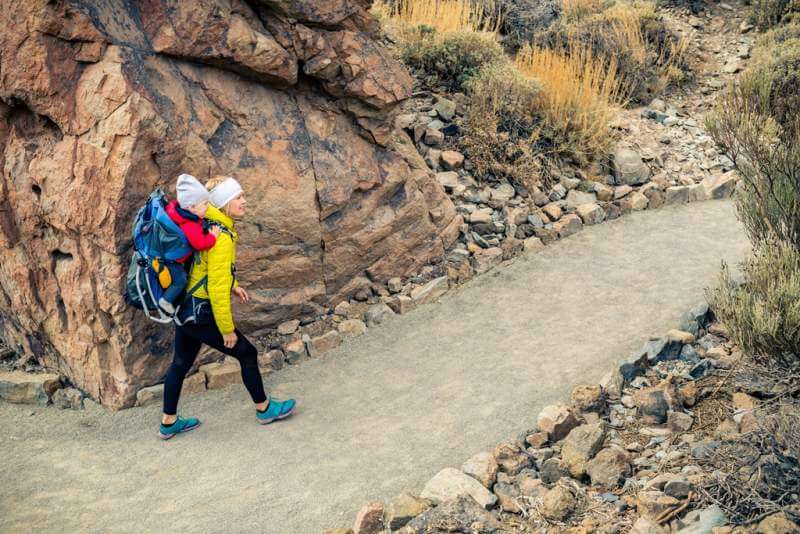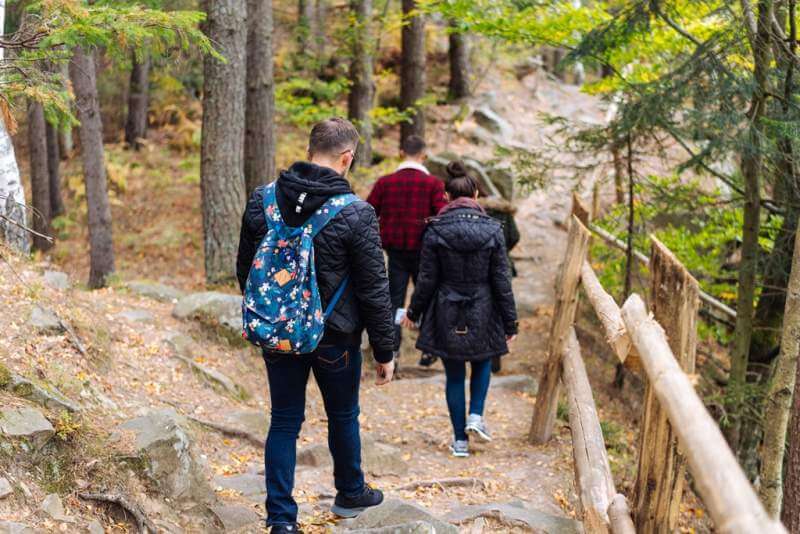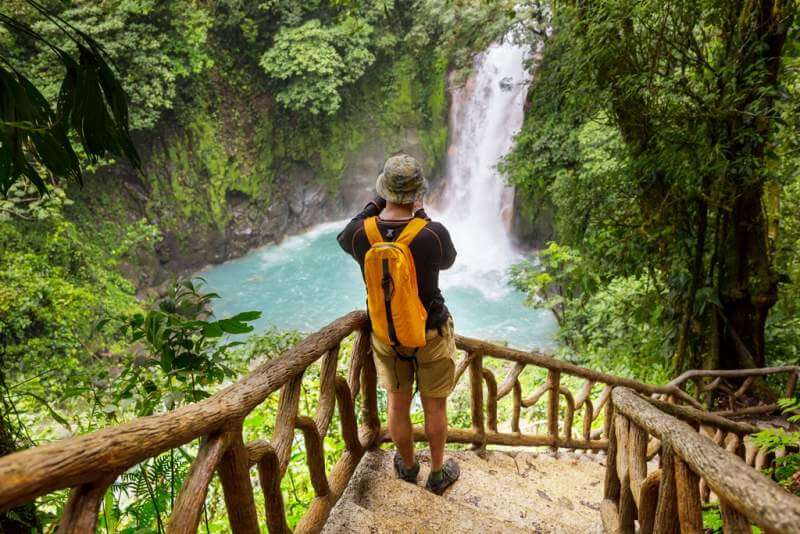Getting into shape for any kind of physical is imperative if you want to enjoy it to its full potential. But it’s easy to dismiss the need to get fit for hiking. The demands on our bodies seemingly don’t go far beyond what we are fully capable of in our daily lives. Walking up stairs is just like climbing a steep hill, right? And surely going downhill is even easier than walking on the flat? We do that everyday. So do we really need to train for a hiking trip at all?
Sure, the basic action of putting one step in front of the other isn’t news to the bodies of most of us. But try doing it for several hours at a time, 5 days in a row. Add in a heavy pack full of gear, a few hundred (or thousand!) feet of elevation, some even more arduous descents and you’ll soon realise why training for hiking is just as important as for any other sport or activity.
Training for day hikes
 If you are new to hiking and want to start doing some short day or half day hikes, embarking on a fully-fledged training plan isn’t essential. First of all, there’s a danger that the training exercises will put you off hiking before you’ve even discovered the joy and freedom of it. Secondly, if you start on short, easy hikes, and build them up slowly, you’ll be getting fitter and stronger anyway.
If you are new to hiking and want to start doing some short day or half day hikes, embarking on a fully-fledged training plan isn’t essential. First of all, there’s a danger that the training exercises will put you off hiking before you’ve even discovered the joy and freedom of it. Secondly, if you start on short, easy hikes, and build them up slowly, you’ll be getting fitter and stronger anyway.
That said, it certainly doesn’t hurt to prepare your body for day hikes. Try these simple tips that you can include in your daily routine:
- Stand on one leg whenever you’re waiting: at the bus stop, the photocopier, the cafe etc (be sure to switch legs).
- Get off the bus to work a stop early or park the car further away — walk the rest.
- Never take the elevator or escalator — always take the stairs, up AND down.
- Skip a step whenever you walk up steps or stairs.
- Seek out hills in the local park or in your town. Walk up them quickly and enjoy the view from the top!
- Do lunges whilst you do your teeth.
Training for multi-day hiking trips
 If you are planning a multi-day hiking trip, you’ll need to get into shape. And you’ll need a good couple of months to do so. A training plan will ensure that all your joints become more stable, especially your knees and ankles. These joints deal with a lot on the trail, from the demands of uneven ground, to the weight of the pack you are carrying. Strengthening them will add stability and also help to prevent injury.
If you are planning a multi-day hiking trip, you’ll need to get into shape. And you’ll need a good couple of months to do so. A training plan will ensure that all your joints become more stable, especially your knees and ankles. These joints deal with a lot on the trail, from the demands of uneven ground, to the weight of the pack you are carrying. Strengthening them will add stability and also help to prevent injury.
Training for hiking will also build up your endurance. This will mean you can do more miles each day if you want to. And covering more ground means more exploration. If you don’t want to do more miles, being faster at hiking will mean you’ll arrive earlier at your destination each evening leaving you more time to enjoy the wilderness in calm and quiet.
Building up distances and pace in your training plan will give you a better idea of what you are capable of. It will give you confidence that you’ll be able to deal with any issues on your hiking trip, should things go awry. If one of your group becomes ill or injured you may have put in some extra miles to seek help. Being fit and strong will mean you won’t have to think twice about this, and it will also minimise the risk of becoming injured yourself, further adding to the problem.
A well structured training plan will include the introduction of hiking with a backpack. Once you have done a few short hikes with a small pack, you should add more and more weight to your pack with every preceding hike. Before too long, carrying a load will become no problem at all — essential when preparing for multi-day hiking trips.
Enjoy your hike
 The result of getting into shape for either short day routes or long multi-day epics is that your enjoyment levels will go through the roof! Your body will be ready for whatever you have to deal with and you’ll have a load more confidence in your ability. That’s not to say your trip will be easy! But it will be a lot easier and way more enjoyable than if you don’t train for it at all.
The result of getting into shape for either short day routes or long multi-day epics is that your enjoyment levels will go through the roof! Your body will be ready for whatever you have to deal with and you’ll have a load more confidence in your ability. That’s not to say your trip will be easy! But it will be a lot easier and way more enjoyable than if you don’t train for it at all.
For more information take a read of Cool of the Wild’s article on how to train for hiking. You’ll find a basic training programme with specific exercise to get your body strong and ready for the trail. And in the meantime, you can get started on some strength exercises that you can do at home, in the park or at the beach with little equipment:
VIDEOS HERE
Mountain climbers:
You can do these in two ways:
The leg and lung burner: jumping feet forwards and backwards whilst keeping your shoulders over your hands.
The core burner: drive your knees towards your chest whilst keeping your shoulders over your hands.
Step ups:
Add an extra challenge and do them on the edge of your sofa or bed. The instability of the soft surface will help work lots of small stabilising muscles in your core, knees, hips, and ankles.
Banded side-steps:
If you don’t have a stretchy band then you can use a stretchy t-shirt or cloth. So long as you keep pushing your knees outwards to maintain tension on the band, you’ll be working the right muscles.
Hip thrusters:
For an easier version, lie on the floor with your knees bent and raise your hips up. For a harder version, take one leg off the floor and raise your hips up. Don’t forget to change legs!
Bulgarian split squats:
This can be done with your back leg on the floor in a lunge position if you are finding the balance hard. Or make it harder by holding weights or books in your hands.
Band pull-aparts:
You can do this exercise without the band to start with. But to get the best results you should use a resistance band as demonstrated.
Lateral step ups:
As with regular step ups, try doing these onto your sofa for an added challenge. Alternatively, you can do them with weights in your hands.
Walking lunges:
If these are too tough to start with, then stand up tall after each lunge. Once you become stronger keep your knees bent and body low for a set number of luges.
Joey Holmes bio
Joey is based in Cornwall, UK, and runs Cool of the Wild. She can’t get enough of being outdoors – whether that’s lounging around the campfire cooking up a feast, hitting the trail in her running shoes, or attempting to conquer the waves on her surfboard – she lives for it. Camping is what she loves to do the most, but has also spent many many hours clinging to the side of a rock face, cycling about the place, cruising the ski-slopes on her snowboard and hiking small mountains and big hills.
